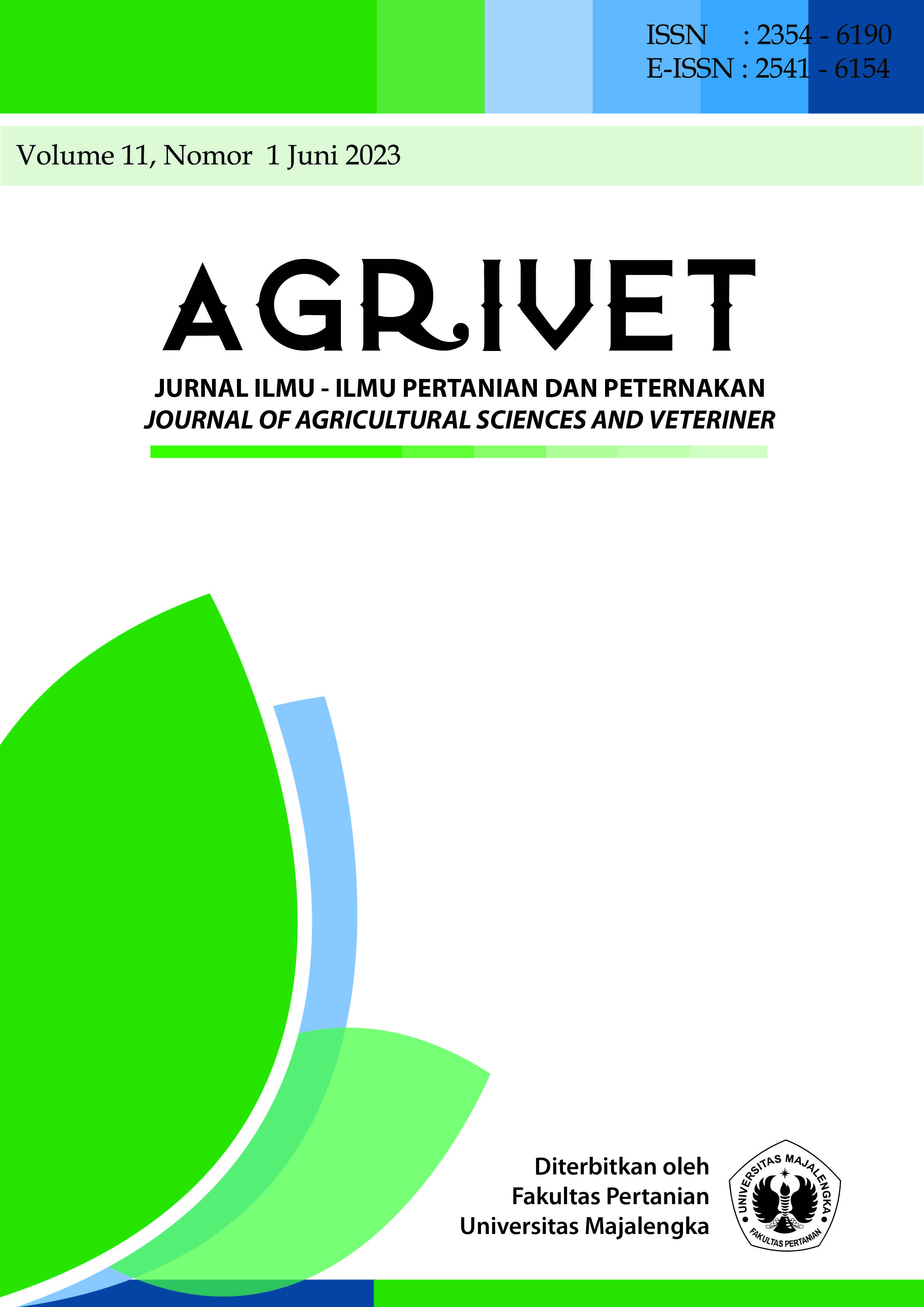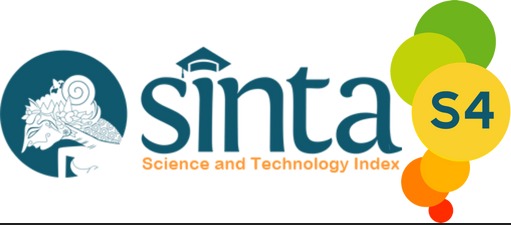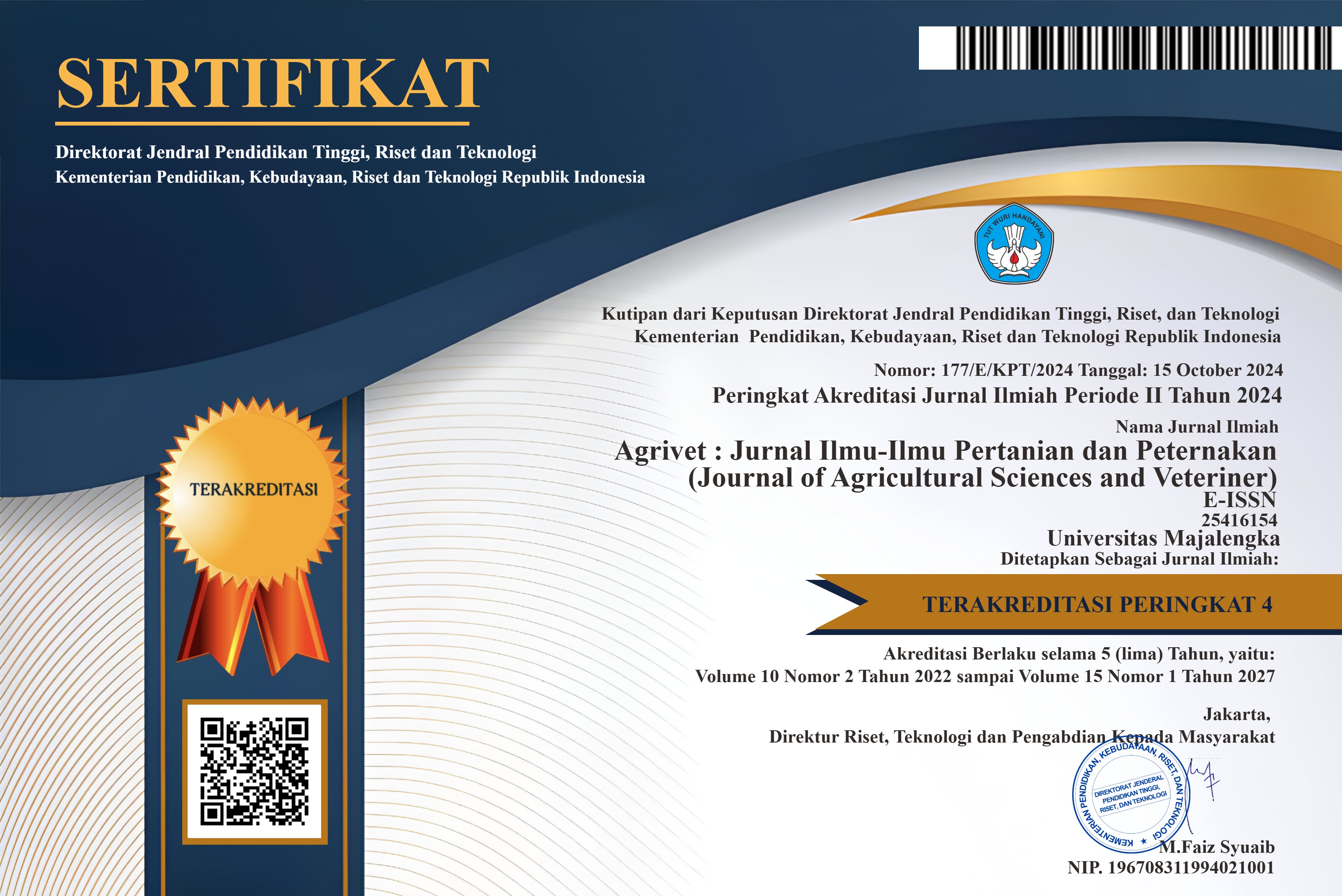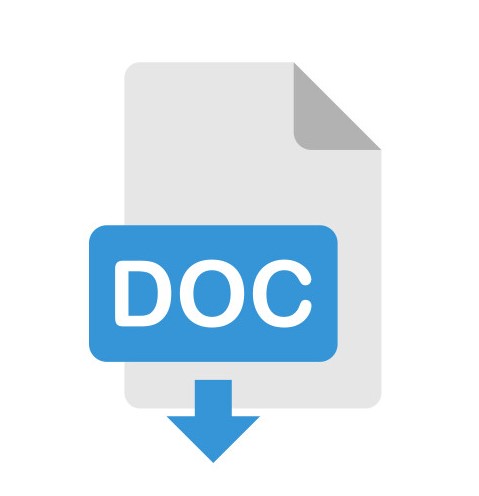Pengaruh waktu penggantian ransum BR 1 dengan BR 2 terhadap bobot potong, bobot karkas, dan lemak abdominal broiler
DOI:
https://doi.org/10.31949/agrivet.v11i1.5288Abstract
This research aimed to see how the impact of time to replace BR 1 with BR 2 ration to slaughtering weight, carcass weight, and abdominal fats of broiler. This research was an experimental method using Complete Randomized Design (CRD) with five treatments and five replication. These treatment consisted of P1: giving BR 1 (1 to 42 days old), P2: giving BR 2 (1 to 42 days old), P3: giving BR 1 (1 to 7 days old), and giving BR 2 (8 to 42 days-old), P4: giving BR 1 (1 to 14 days-old) and giving BR 2 (15 to 42 days-old), P5: giving BR 1 (1 to 21 days-old) and giving BR 2 (22 to 42 days-old). The observed variables were slaughtering weight, carcass weight, and abdominal fats of the broiler. The collected data were analyzed by ANOVA and Duncan's test. The results showed that various feeding timing techniques from starter feed (BR1) to grower feed (BR2) did not make a significant difference (p>0.05) in broiler slaughter weight, carcass weight, and abdominal fat. Each of these weights is in the range of 2617.86 – 2754.24 g/head; 2010.51 – 2076.69 g/head or 75.00 – 76.80%; and 41.70 – 44.40 g/head. It can be concluded that all techniques when changing feed types from BR1 to BR2 can be carried out by breeders, however, the economic value of these techniques must be considered because the two types of feed have different prices.
Keywords:
Broiler, Slaughtering Weight, Carcass Weight, Abdominal Fats, Replacing rationDownloads
References
Amrullah, I. K. (2004). Nutrisi Ayam Broiler. Lembaga Satu Gunungbudi.
Anwar, P., Jiyanto, & Afnida Santi, M. (2019). Persentase karkas, bagian karkas dan lemak abdominal broiler dengan suplementasi andaliman (Zanthoxylum acanthopodium DC) di dalam ransum. Ternak Tropika, Journal of Tropical Animal Production, 20(2), 172–178. https://doi.org/10.21776/ub.jtapro.2019.020.02.10
Charoen Pokphand Indonesia. (2006). Standar Performa Mingguan Ayam Ras Pedaging CP707.
Cobb Broiler Management Guide 2018. (2018). Cobb broiler management guide 2018. Cobb-Vantress.
Imamudin, Atmomarsono, U., & Nasoetion, M. H. (2012). Pengaruh berbagai frekuensi pemberian pakan pada pembatasan pakan terhadap produksi karkas ayam broiler. Animal Agricultural Journal, 1(1), 87–98.
Jumiati, S., Nuraini, & Aka, R. (2017). Bobot potong, karkas, giblet dan lemak abdominal ayam broiler yang temulawak (Curcuma xanthorrhiza, Roxb) dalam pakan. JITRO, 4(3), 11–19. https://doi.org/https://doi.org/10.33772/jitro.v4i3.3634
Ketaren, P. P. (2010). Kebutuhan gizi ternak unggas di Indonesia. Wartazoa, 20(4), 172–180.
Khothijah, S., Erwan, E., & Irawati, E. (2021). Performa Ayam Broiler yang Diberi Ekstrak Daun Jambu Mete (Anacardium occidentale Linn) dalam Air Minum. Jurnal Ilmu Nutrisi Dan Teknologi Pakan, 19(1), 19–23. https://doi.org/http://dx.doi.org/10.29244/jintp.19.1.19-23
Kic, P., Ruzek, L., Levinka, Z., Zita, L., & Gardianova, I. (2012). Pollution of indoor environment in poultry housing. In: 11th International Scientific Conference Engineering for Rural Development, 480–483.
Kusuma, R. A., Dwiloka, B., & Mahfudz, L. D. (2014). Berat karkas, nonkarkas dan lemak abdominal pada ayam broiler yang diberi pakan mengandung Salvinia molesta. Animal Agriculture Journal, 3(2), 249–257.
Nahashon, S. N., Adefope, N., Amenyenu, A., & Wright, D. (2005). Effects of dietary metabolizable energy and crude protein concentration on growth performance and carcass characteristics of French guinea broiler. Poultry Science, 84, 337–344.
Pratikno, H. (2011). Lemak Abdominal Ayam Broiler ( Gallus sp .) Karena Pengaruh Ekstrak Kunyit ( Curcuma domestica Vahl.). BIOMA, 13(1).
Rasyaf, M. (2003). Beternak Ayam Pedaging. PT Penebar Swadaya.
Salam, S., Fatahilah, A., Sunarti, D., & Isroli. (2013). Berat Karkas dan Lemak Abdominal Ayam Broiler yang diberi Tepung Jintan Hitam (Nigella sativa) dalam Ransum selama Musim Panas. Sains Peternakan, 11(2), 84–90.
Sembiring, P. (2001). Diktat penuntun praktikum produksi ternak unggas. Universitas Sumatera Utara Press.
Solangi, A. A., Baloch, G. M., Wagan, P. K., Chachar, B., & Memon, A. (2003). Effect of different level of dietary protein on growth of broiler. Journal of Animal and Veterinary Advances, 2(5), 301–304.
SNI 8173.3: 2015, Pub. L. No. SNI 8173.3: 2015. (2015).
Steel, R. G. D., & Torrie, J. H. (1995). Prinsip dan prosedur statistika: Suatu pendekatan biometrik (2nd ed.). PT Gramedia Pustaka Utama.
Subekti, K., Abbas, H., & Zura, K. A. (2012). Kualitas Karkas (Berat Karkas, Persentase Karkas Dan Lemak Abdomen) Ayam Broiler yang Diberi Kombinasi CPO (Crude Palm Oil) dan Vitamin C (Ascorbic Acid) dalam Ransum sebagai Anti Stress. Jurnal Peternakan Indonesia, 14(3), 447–453. https://doi.org/https://doi.org/10.25077/jpi.14.3.447-453.2012
Sudarto, Y., & Siriwa, A. (2007). Ransum Ayam dan Itik (IX). Penebar Swadaya.
Suryanah, S., Widjaja, N., Akhdiat, T., Permana, H., & Setiawan, I. (2023). Pengaruh waktu penggantian ransum BR1 dengan BR2 terhadap performa broiler. COMPOSITE: Jurnal Ilmu Pertanian, 5(1), 25–30. https://doi.org/https:/doi.org/10.37577/composite.v5i1.500
Witantra. (2011). Pengaruh Pemberian Lisin dan Metionin terhadap Persentase Karkas dan Lemak Abdominal pada Ayam Pedaging Asal Induk Bibit Muda dan Induk Bibit Tua. Artikel Ilmiah. Universitas Airlangga, Surabaya.
Woro, I. D., Atmomarsono U, & Muryani, R. (2019). Pengaruh Pemeliharaan pada Kepadatan Kandang yang Berbeda terhadap Performa Ayam Broiler. Jurnal Sain Peternakan Indonesia, 14(4), 418–423. https://doi.org/https://doi.org/10.31186/jspi.id.14.4.418-423
Published
How to Cite
Issue
Section
License
Copyright (c) 2023 Pandu Purnama, Syifa Nurjannah, Nilawati Widjaya, Tedi Akhdiat, Hilman Permana

This work is licensed under a Creative Commons Attribution-ShareAlike 4.0 International License.
An author who publishes in the Jurnal Agrivet agrees to the following terms:
- Author retains the copyright and grants the journal the right of first publication of the work simultaneously licensed under the Creative Commons Attribution-ShareAlike 4.0 License that allows others to share the work with an acknowledgment of the work's authorship and initial publication in this journal
- The author is able to enter into separate, additional contractual arrangements for the non-exclusive distribution of the journal's published version of the work (e.g., post it to an institutional repository or publish it in a book) with the acknowledgment of its initial publication in this journal.
- The author is permitted and encouraged to post his/her work online (e.g., in institutional repositories or on their website) prior to and during the submission process, as it can lead to productive exchanges, as well as earlier and greater citation of the published work









